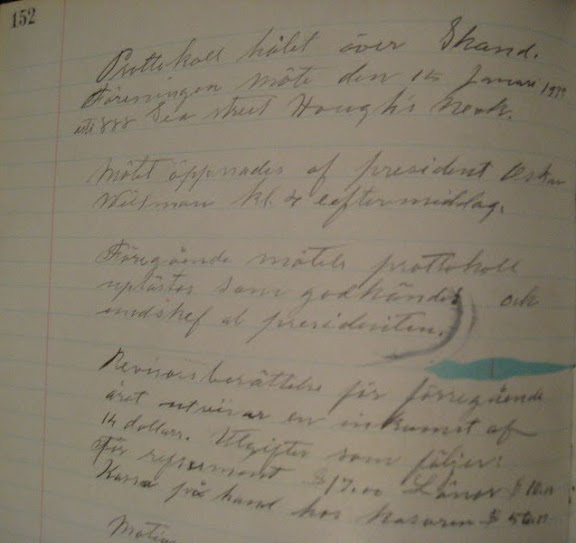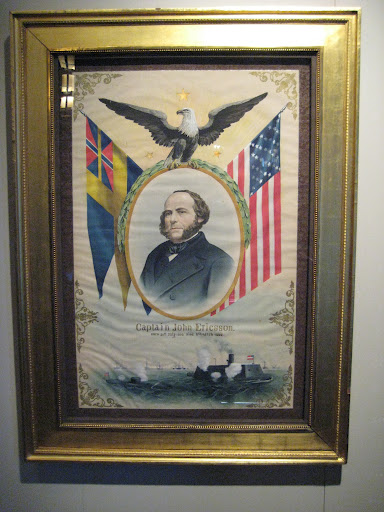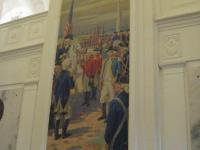We're currently in the pilot phase of HCI-PSAR, and so far Michael and I have been surveying much faster than anticipated. We were only meant to visit 25 repositories over the course of a whole year, but it's been about 6 months and we've already finished #25: the American Swedish Historical Museum! Our survey rate varies somewhat depending on the archives, but the Swedish Museum took a lot longer than most. Not that we minded -- the Swedish Museum is a great place to spend a day, or three! But it taught us a few lessons about what factors lead to a slower rate of surveying. As it turns out, a little bit of knowledge is a dangerous thing...
1. Language. It should be obvious that evaluating and describing the content of foreign language archival materials is, if not impossible, darn close to it. As it happens, though, I actually do know a little bit of Swedish: I spent a semester in Stockholm during college, and took a beginner's class when I got back. I was looking forward to dusting off those old skills, but quickly found myself shouting in frustration "Jag vet inte!" ("I don't know!") more often than I care to admit.
 For one thing, reading handwriting in a foreign language -- especially 19th, or even 18th century handwriting -- is a lot harder than reading from a textbook or a computer screen. As an archivist I've gotten quite good at reading old manuscripts in English. Before the Swedish Museum, though, I didn't recognize how often my brain fills in indecipherable letters (or even words) based on context without me even realizing. But my Swedish vocabulary isn't good enough for me to make educated predictions in the same way, so even with my grammar knowledge and a dictionary at my side, I couldn't look up unknown words because I couldn't read all of the letters.
For one thing, reading handwriting in a foreign language -- especially 19th, or even 18th century handwriting -- is a lot harder than reading from a textbook or a computer screen. As an archivist I've gotten quite good at reading old manuscripts in English. Before the Swedish Museum, though, I didn't recognize how often my brain fills in indecipherable letters (or even words) based on context without me even realizing. But my Swedish vocabulary isn't good enough for me to make educated predictions in the same way, so even with my grammar knowledge and a dictionary at my side, I couldn't look up unknown words because I couldn't read all of the letters.
My frustration was amplified by the presence of abbreviations, misspellings, and antiquated sayings that are par for the course in any archival manuscript. At one point, I opened up a notebook and proudly guessed/translated "Prottokall av Skandinaviska Föreningen ord. möte den 17 Januari 1875" to mean "Minute of the Scandinavian Society word meeting, January 17, 1875." Before I got too carried away patting myself on the back, I started to wonder what a "word meeting" was, and what might it have to do with a Scandinavian Society, anyway? That's when I flipped to another page and realized that "ord." was short for "ordinarie," as in, "a regular meeting" of the society. Perhaps I subconsciously was hoping for a "word meeting" where I could pick up some more vocabulary!
My Swedish knowledge, limited as it is, did allow us to survey collections we might have had to otherwise skip over. But it also took much longer to survey those collections than it usually takes us for English-language collections.
 2. Existing inventories. It is counter-intuitive, but true, that the existence of an inventory before Michael and I arrive to survey sometimes causes us to spend more time on a collection. Here I am not talking about legacy finding aids -- if a repository already has a collection-level description with all the critical information already recorded, we skip re-surveying the collection and save time by just plugging the information into Archivists' Toolkit. More often, the repository has a partial inventory lists that some items but lacks basic pieces of information such as extent (the size of the collection) and date span. In those cases, we have to survey the collection to fill in all the blanks and ensure that the inventory list is complete. But it seems like a shame to not make use of the inventory data we have been given, when it would take comparatively little effort to make the data useable. This is where we sometimes fall into a time-trap. Our methodology dictates that we do not describe collections in much detail--just a brief scope note to give an overview, without a container list or even a series break-down. But if we already have an item-level inventory that covers most of the items, we find ourselves adding descriptions for the remaining items just to make sure the list is consistent. Then, inevitably, repurposing the inventory is never as straightforward as we hope. Somehow it always takes longer than we think it will to clean up the data and massage it into a useable format.
2. Existing inventories. It is counter-intuitive, but true, that the existence of an inventory before Michael and I arrive to survey sometimes causes us to spend more time on a collection. Here I am not talking about legacy finding aids -- if a repository already has a collection-level description with all the critical information already recorded, we skip re-surveying the collection and save time by just plugging the information into Archivists' Toolkit. More often, the repository has a partial inventory lists that some items but lacks basic pieces of information such as extent (the size of the collection) and date span. In those cases, we have to survey the collection to fill in all the blanks and ensure that the inventory list is complete. But it seems like a shame to not make use of the inventory data we have been given, when it would take comparatively little effort to make the data useable. This is where we sometimes fall into a time-trap. Our methodology dictates that we do not describe collections in much detail--just a brief scope note to give an overview, without a container list or even a series break-down. But if we already have an item-level inventory that covers most of the items, we find ourselves adding descriptions for the remaining items just to make sure the list is consistent. Then, inevitably, repurposing the inventory is never as straightforward as we hope. Somehow it always takes longer than we think it will to clean up the data and massage it into a useable format.
The American Swedish Historical Museum already had inventories for portions of their archival collections, and that caused us to spend longer than we typically do recording item-level detail and reformatting their old inventory data. In the end, though, the finding aids that make use of existing inventories are more detailed, and ultimately more helpful to researchers, than the more cursory finding aids we usually produce.
3. Great collections! This "problem" is not unique to the American Swedish Historical Museum, as Michael and I often find ourselves absorbed in surveying the collections that we find most interesting. Perusing letters and ephemera relating to Jenny Lind (the "Swedish Nightingale" who toured the U.S. with P.T. Barnum in the 1850s), or examining the original manuscript of Fredrika Bremer's Hertha (a feminist novel that precipitated an end to coverture in Sweden), it was hard to tear ourselves away. But the collection at the Swedish Museum with the most research potential, by far, is the John Ericsson Collection.  Ericsson, an inventor and engineer, is best known for designing the USS Monitor and innovating propeller-driven boats. The USS Monitor, an ironclad warship, contributed to the Union victory in the Civil War, and one of his ships was the first propeller-driven steamer to cross the Atlantic. The John Ericsson collection at the Swedish Museum spans about 16 linear feet, and encompasses correspondence, financial records, plans and drawings, patents and contracts, scrapbooks, and photographs. It is an invaluable resource for the study of the Civil War, mechanical engineering, famous Swedes in America, and innumerable other topics.
Ericsson, an inventor and engineer, is best known for designing the USS Monitor and innovating propeller-driven boats. The USS Monitor, an ironclad warship, contributed to the Union victory in the Civil War, and one of his ships was the first propeller-driven steamer to cross the Atlantic. The John Ericsson collection at the Swedish Museum spans about 16 linear feet, and encompasses correspondence, financial records, plans and drawings, patents and contracts, scrapbooks, and photographs. It is an invaluable resource for the study of the Civil War, mechanical engineering, famous Swedes in America, and innumerable other topics.

